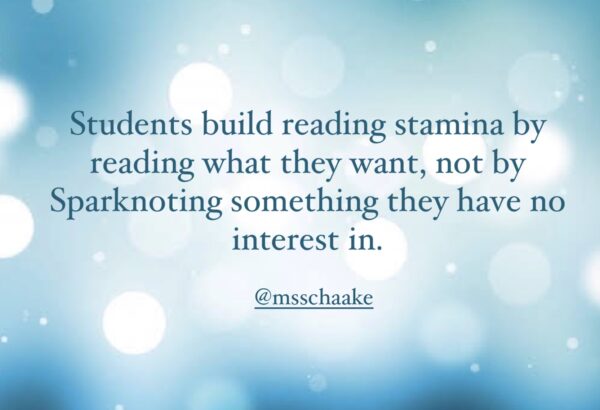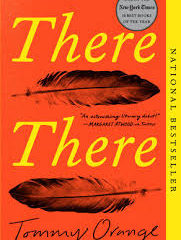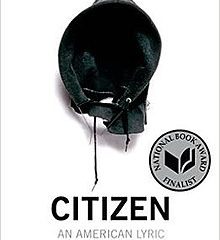Choice Reading or Bust
Choice reading is the hill I’m willing to die on. I said it my first year of teaching, rather glibly, but I still believe wholeheartedly in the practice.
Choice reading, SSR (sustained silent reading) or the like, often goes away after middle school, as the pressure of curriculum inevitably mounts. But, I don’t think the pressure to read and analyze Lord of the Flies is alleviated by removing choice reading.

Students build reading stamina by reading what they want, not by Spark Noting something they have no interest in.
Instead, according to a graduate paper at Bridgewater State University, and what I have seen anecdotally in my own classroom, “When given more choice, students respond more positively, feel motivated to read and are more likely to engage in class discussions and activities.”
Although I am definitely the kind of English teacher that would like to do away with the canon and textbooks altogether, I also know that as an employed professional, there are many rules I can bend, but a few I probably shouldn’t break altogether.
Enter, choice reading.
High-Engagement, Low-Stakes
Choice reading is definitely not a new concept. The National Council of Teachers of English (NCTE) has a statement supporting it, claiming the benefits for reading stamina, language development, and cognitive challenge.
NCTE explains that, “Student choice in text is essential because it motivates, engages, and reaches a wide variety of readers.”
Even if I had unlimited funds to buy new books every year, it would still be nearly impossible to choose a few whole class novels that truly fit the “wide variety of readers” in my classroom.
NCTE goes on to explain that choice reading is meant to “build habitual readers with conscious reading identities” and allow students to “practice reading skills in a high-engagement, low-stakes environment.”
I take this focus to heart in my classroom.
We read every Friday, and students don’t need to do anything other than read and answer a quick reflection. I implemented the reflection this year, a simple Google form, as a way to help them track what they read. I also always throw in a question that helps me do an SEL check in (What are you proud of this week? What’s something you’re going to do to take care of yourself this weekend?)
At the end of the quarter, they need to have finished at least one book. Then, they do a book talk with our librarian. She asks them a few comprehension and interest questions and picks a passage for them to explain. We do these talks in small groups to help students practice speaking in front of peers and normalize talking about what we’re reading.
And, that’s all the accountability I ask for. I don’t have page number requirements and, yes, graphic novels absolutely count.
Create Readers, not Sparknoters
While some of my colleagues argue that reading certain texts shouldn’t necessarily be fun, students just need to learn how to “buckle down” and focus, I’m too much of a realist to agree. I know that “buckling down” might look like Googling a summary, which doesn’t solve anything.
Teaching the canon, and only the canon is a classic (no pun intended) case of pounding a square peg into a round hole.
Edutopia writes that “the disconnect between the canon and its intended audience has become an epidemic, driven by rapid changes in the composition of American schools and the emergence of always-on digital platforms that vie for kids’ attention. By middle and high school, teachers concede, many of today’s students simply aren’t reading at all.”
All educators know that these “digital platforms” have increased exponentially since that article was published in 2019. We are constantly vying for our students’ attention, desperate to pull them away from their screens.
So, when a student walks into my room on Friday, pockets their phone and says, “Oh, yeah, it’s choice reading day. Sweet!” I can’t help but call that a win.
The Joy of Reading
My goal as an English teacher is to create lifelong readers. They don’t all need to love reading novels or highlighting nonfiction like I do. But, they will all have myriad opportunities to flex their reading muscles in almost every facet of their lives–from job applications to voters pamphlets. I believe the attitudes and practices I foster around reading are critical.
I’ve been teaching for six years, and every year, I hear so many responses from students like this:
“I have always hated reading, but I actually like this one.”
“Ms. Schaake, this is the first book I’ve actually read since like second grade.”
*laughs during silent reading* “I can’t believe I just laughed. Out loud. To a book.”
“Reading is like, cool, because you’re sort of making a movie in your head, you know?”
My favorite so far this year comes from a student who’s very vocal about his ADHD, dislike of reading, and desire to be a Navy Seal.
“I’ve never really felt empathy for a character in a book before. But, I seriously feel what he’s going through. I can’t put it down.”
In today’s politically divisive, persistently digital world, we could all definitely also use more empathy, and more time to read.



 Neil Postman, and, being the serious minded young person I was, I thought hard about both the messages I received and the medium through which I received them.
Neil Postman, and, being the serious minded young person I was, I thought hard about both the messages I received and the medium through which I received them.
